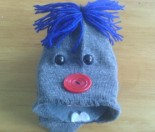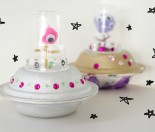Young children love to paint, and there are so many different art activities they can enjoy with a pot of paint. Art activities are supposed to be fun, so try not to stress about the mess and let them enjoy being creative.
Painting is so much fun for kids, but often parents leave it as an activity for school or day care, because they are worried about the mess. Granted, painting is not the tidiest of activities, but it doesn’t have to be a war zone either. There are lots of ways you can make painting activities a little less messy. Here are some ideas for your preschool & junior primary school children.
Water based poster or tempera paints are the easiest to remove from clothes and carpet, but it would be shame to miss out on other painting experiences just for the sake of staying clean. Invest in a wipeable art apron, or grab an old shirt which your child can use as their painting smock. A tarpaulin is a great way to cover the floor, and it helps provide a specific area for children to keep their activities in. Make sure you keep the paint side up, every time you lay it out.
If bringing paints inside is just too much to bear, set up an old picnic table outside, or lay out a tarpaulin on the grass. Painting isn’t as painful as it seems, and who knows, if you can work through a little mess, you may even enjoy some painting yourself.
Child’s Birthday gift? Find a great selection of popular Books & Authors.Age: 0 1 2 3 4 5 6 7 8 9 10 11 12 Years Old |
||||
|
|
|
|
|
|
Here are some great painting activities to get you started.
- Instead of giving your child standard brushes, let them experiment with a range of different brushes or tools. Educational toy stores sell lots of different painting tools including sponge brushes, fan brushes, rollers and scrapers, or let them explore household objects as a way to apply the paint.Put small amounts of paint into saucers and give them feathers, toothpicks and cotton buds to use. Other great tools for them to explore are plastic forks, sponges, corrugated cardboard, hair combs, and cotton wool.
- Cut a piece of paper so that it is the same height as a Pringles tin or baby formula can. Roll the paper up (like you are making a telescope), and put the paper inside the tin. The paper will start to unroll, and sit up tight against the sides of the can.Drop 2 or 3 marbles into saucers of different coloured paint, then drop the marbles into the tin can. Put on the lid and have your kids shake the can about. The marbles leave ‘snail prints’ all over the paper, and your child loves being allowed to make lots of noise!
- Make string prints by laying a piece of string in a saucer of paint, making sure it is well coated.Carefully pull the string out of the dish and arrange it on a piece of paper, then lie a clean piece of paper on top. Press down firmly with your top piece to make a cool string print. Repeating the process with more pieces of string, and different coloured paint will let your child create some truly awesome designs.
- Bubble printing is a fun way to use paint, and it is a great way to teach children about sucking and blowing. Start by filling a bowl with water up to about the 2/3 mark, then add a good squirt of dishwashing liquid and splash it around. Add a tablespoon or two of water based paint and mix it until it is all dissolved.Using a straw, have your child blow bubbles in the bowl, until the mixture rises right to the top. Lay a piece of paper over the top of the bowl, and the coloured bubbles make awesome bubble prints.
- Teach children about mixing colours by making blotter bugs. Fold a piece of paper in half, then open it to make a line down the centre. Ask them to put a splodge of one colour paint on one half, then a splodge of a second colour paint on the other. Fold the paper in half again, and press it down to mix the colours. Once the paint is dry, children can use a black marker to add details and turn the blot into a bug.
- Mix together paint, PVA glue and dishwashing liquid to make a transparent mixture you can paint straight onto the window. The sun shines through the paint giving a stained glass effect, and once the paint is dry you can simply peel it off. If you are a little worried about painting on your new French doors, give your children pieces of overhead transparency to use, and simply tape it to the window.
- Brush water onto a thick piece of paper so that the whole page is completely damp. Have your child flick dry powder paint onto the page, and watch the magic appear. The powder paint mixes with the water on the page and creates amazing Monet like paintings. These paintings always look incredible, but can get a bit messy if your child gets carried away with the flicking. To avoid painted curtains, try doing this activity outside.
- If your child is dying to paint, but you don’t have the time, energy or inclination to set it all up and supervise, let them paint the fence – REALLY! Simply fill a tin can with water and let them use a big brush to ‘paint’ the fence. The water darkens the surface of the wood, and looks just like real paint until it soaks in and disappears. They can paint the fence over and over, and the job will never be done for long.
- Mix together wallpaper paste and powder paint to make coloured finger paint. Your child can make patterns with the paint, then stick on collage materials while the paint is still wet. It’s a great way to combine painting and collage in one go.
Remember, painting is all about having fun. Don’t worry about the end product so much, and let your child enjoy the process. You will be surprised by what they come up with.











